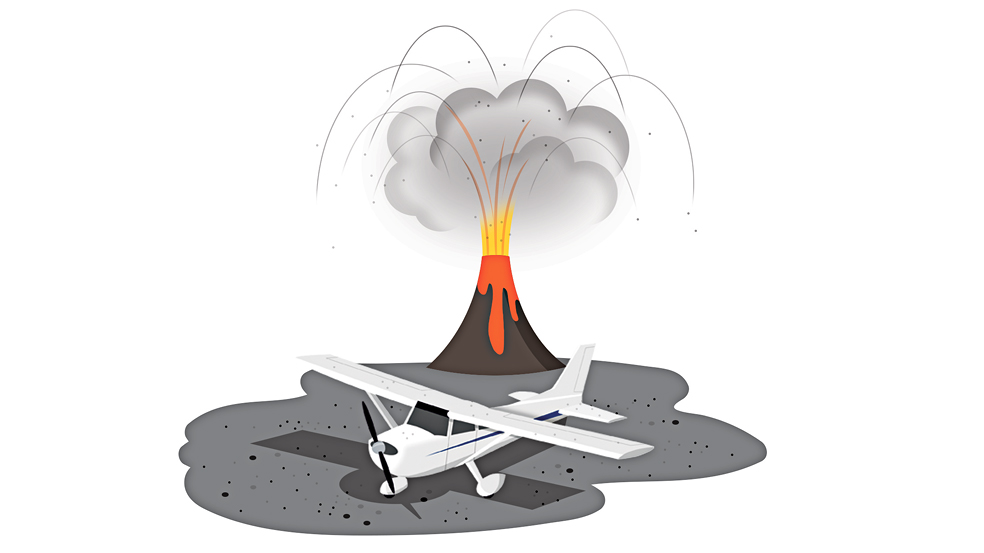 Checkride-ready
Checkride-ready
See how you measure up to FAA standards with questions from the AOPA Pilot Information Center.
1. A blue segmented circle on a sectional chart depicts which class airspace?
A. Class D.
B. Class C.
C. Class B.
2. Which operation would be described as preventive maintenance?
A. Repair of portions of skin sheets by making additional seams.
B. Replenishing hydraulic fluid.
C. Repair of landing gear brace struts.
3. Except in Alaska, during what time period should lighted position lights be displayed on an aircraft?
A. One hour after sunset to one hour before sunrise.
B. End of evening civil twilight to the beginning of morning civil twilight.
C. Sunset to sunrise.
4. What is the specific fuel requirement for flight under VFR during daylight hours in an airplane?
A. Enough to complete the flight at normal cruising speed with adverse wind conditions.
B. Enough to fly to the first point of intended landing and to fly after that for 30 minutes at normal cruising speed.
C. Enough to fly to the first point of intended landing and to fly after that for 45 minutes at normal cruising speed.
5. If the airport elevation is 1,295 feet msl, and the AWOS is reporting a ceiling of 1,400 overcast, at approximately what indicated altitude would you anticipate entering the base of the clouds?
A. 1,400 feet.
B. 2,700 feet.
C. 105 feet.
 Ace
Ace
Can you correctly answer these questions from retired TWA captain and 28,000-hour pilot Barry Schiff?
6. True or false? Your parked airplane is coated with volcanic ash. The best way to remove the ash is to blow it off with an air hose.
7. Which of the following does not belong?
A. 3.8 Gs
B. 4.4 Gs
C. 5.7 Gs
D. 6 Gs
8. The minimum turning distance (while taxiing) provided in pilot’s operating handbooks usually represents the turning radius of the
A. nosewheel.
B. outside main landing gear.
C. outside wing tip.
D. outside edge of horizontal tail surface.
9. True or false: According to the Aeronautical Information Manual, the tarmac is defined as all paved aircraft movement areas, excluding taxiways and runways.
10. Describe a relatively easy method of converting degrees Celsius into degrees Fahrenheit without using a chart, calculator, or pen and paper.
Final Exam Answers
1. The correct answer is A. Generally, Class D airspace extends upward from the surface to 2,500 feet above the airport elevation. The top of the Class D airspace is expressed as a two-digit number near the airport symbol, and denotes the height, in hundreds of feet, above mean sea level (msl). (Aeronautical Information Manual 3-2-5)
2. The correct answer is B. Paragraph C of Appendix A to FAR Part 43 details 31 items that are considered to be preventive maintenance—work that may be performed on an aircraft by the owner. Preventive maintenance is limited to those 31 items. Once completed, the owner must endorse the logbooks appropriately.
3. The correct answer is C. Position lights are the steady burning lights that include a red light on the left wing, a green light on the right wing, and a white light on the tail. All must be functioning properly and must be illuminated from sunset to sunrise. (FAR 91.209)
4. The correct answer is B. This is the absolute minimum amount of fuel that must be on board prior to departure. Any additional fuel to be carried is at the discretion of the pilot in command. (FAR 91.151)
5. The correct answer is B. Add the base of the ceiling to the field elevation to get the mean sea level altitude of the cloud base. The cloud layer is reported as height above ground. If the ground is 1,295 feet, 1,400 feet above this is just about 2,700 feet msl, as indicated on the aircraft’s altimeter.
6. False. According to the Alaska Airmen’s Association, the best way to remove ash is to flood it off with water.
7. The correct answer is C. (5.7 Gs) does not belong. The others are the minimum limit load factors for normal (3.8 Gs), utility (4.4 Gs), and aerobatic (6 Gs) aircraft certified under Part 23 of the federal aviation regulations.
8. The correct answer is C. In the case of some long airplanes with relatively short wings, the tail could have the largest turning radius.
9. False. Tarmac (a registered trademark) is similar to tarmacadam (also known as blacktop), a type of pavement made by pouring tar over crushed stone.
10. Double the value of Celsius, deduct 10 percent of the result, and add 32. For example, if the temperature is 20 degrees C, doubling that would be 40. Ten percent of that is 4, which when subtracted from 40 equals 36. Adding 32 results in a temperature of 68 degrees F. Work this problem a few times, and you’ll see how fast and easy it is.


